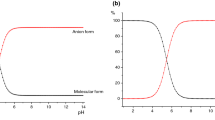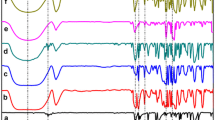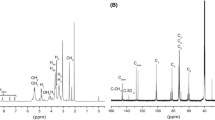Abstract
The influence of β-cyclodextrin on the solubility, protolytic properties, and complex formation behavior of 2-aminodiphenylamine was studied using UV spectroscopy. In accordance with the results of the spectrophotometric titration that was carried out in phosphate buffer solutions, the presence of β-cyclodextrin does not change the value of the deprotonation constant of the primary amino group of 2-aminodiphenylamine. This fact confirms that the primary amino group is not involved in the complex formation and interaction between β-cyclodextrin and 2-aminodiphenylamine occurs via the phenylimine moiety. The phase solubility profiles of 2-aminodiphenylamine in the presence of β-cyclodextin, at pH = 1.00 and pH = 5.00, indicate formation of inclusion complexes with limited solubility and can be classified as Higuchi–Connors curves of BI and BS type, respectively. The stoichiometry of the complexes and the apparent stability constants that characterize the β-cyclodextrin complexes with both protonated and neutral forms of 2-aminodiphenylamine were estimated from the dependence of absorbance intensity of the guest molecule at increasing amounts of β-cyclodextrin by the Ketelar equation. The linearity of the plots in the coordinates of the Ketelar equation proves the formation of 1:1 inclusion complexes for both protolytic forms of 2-aminodiphenylamine. It was found that inclusion complex formation is preferable for the neutral form of 2-aminodiphenylamine.









Similar content being viewed by others
References
Lehn, J.M.: Supramolecular chemistry: concepts and perspectives. VCH Verlagsgesellschaft, Weinheim (1995)
Connors, K.A.: The stability of cyclodextrin complexes in solution. Chem. Rev. 97, 1325–1357 (1997)
Matsui, Y., Nishioka, T., Fujita, T.: Quantitative structure-reactivity analysis of the inclusion mechanism by cyclodextrins. Top. Curr. Chem. 128, 61–89 (1985)
Loftsson, T., Jarho, P., Masson, M., Jarvinen, T.: Cyclodextrins in drug delivery. Expert Opin. Drug Deliv. 2, 335–351 (2005)
Szejtli, J.: Introduction and general overview of cyclodextrin chemistry. Chem. Rev. 98, 1743–1753 (1998)
Roik, N.V., Belyakova, L.A.: Thermodynamic, IR spectral and X-ray diffraction studies of the “β-cyclodextrin-para-aminobenzoic acid” inclusion complex. J. Incl. Phen. Macrocycl. Chem. 69, 315–319 (2011)
Trofymchuk, I.M., Belyakova, L.A., Grebenyuk, A.G.: Study of complex formation between β-cyclodextrin and benzene. J. Incl. Phenom. Macrocycl. Chem. 69, 371–375 (2011)
Roik, N.V., Belyakova, L.A.: Cyclodextrin-based drug stabilizing system. J. Mol. Struct. 987, 225–231 (2011)
Park, C., Oh, K., Lee, S.C., Kim, C.: Controlled release of guest molecules from mesoporous silica particles based on a pH-responsive polypseudorotaxane motif. Angew. Chem. Int. Ed. 46, 1455–1457 (2007)
Angelos, S., Yang, Y.W., Patel, K., Stoddart, J.F., Zink, J.I.: pH-responsive supramolecular nanovalves based on cucurbit[6]uril pseudorotaxanes. Angew. Chem. Int. Ed. 47, 2222–2226 (2008)
Klichko, Y., Khashab, N.M., Yang, Y.W., Angelos, S., Stoddart, J.F., Zink, J.I.: Improving pore exposure in mesoporous silica films for mechanized control of the pores. Micropor. Mesopor. Mater. 132, 435–441 (2010)
Li, Z., Barnes, J.C., Bosoy, A., Stoddart, J.F., Zink, J.I.: Mesoporous silica nanoparticles in biomedical application. Chem. Soc. Rev. 41, 2590–2605 (2012)
Meng, H., Xue, M., **a, T., Zhao, Y.L., Tamanoi, F., Stoddart, J.F., Zink, J.I., Nel, A.E.: Autonomous in vitro anticancer drug release from mesoporous silica nanoparticles by pH-sensitive nanovalves. J. Am. Chem. Soc. 132, 12690–12697 (2010)
Ambrogio, M.W., Thomas, C.R., Zhao, Y.L., Zink, J.I., Stoddart, J.F., : Mechanized silica nanoparticles: a new frontier in theranostic nanomedicine. Acc. Chem. Res. 44, 903–913 (2011)
Yang, Y.W.: Towards biocompatible nanovalves based on mesoporous silica nanoparticles. Med. Chem. Commun. 2, 1033–1049 (2011)
Gao, Y., Yang, C., Liu, X., Ma, R., Kong, D., Shi, L.: A multifunctional nanocarrier based on nanogated mesoporous silica for enhanced tumor-specific uptake and intracellular delivery. Macromol. Biosci. 12, 251–259 (2012)
Roik, N.V., Belyakova, L.A.: Sol-gel synthesis of MCM-41 silicas and selective vapor-phase modification of their surface. J. Solid State Chem. 207, 194–202 (2013)
Roik, N.V., Belyakova, L.A.: Chemical design of pH-sensitive nanovalves on outer surface of mesoporous silicas for controlled storage and release of aromatic amino acid. J. Solid State Chem. 215, 284–291 (2014)
Barry, V.C., Belton, J.G., Conalty, M.L., Twomey, D.: Anti-tubercular activity of oxidation products of substituted o-phenylene diamines. Nature 162, 622–623 (1948)
Cotarelo, M.A., Huerta, F., Mallavia, R., Morallon, E., Vazquez, J.L.: On the polymerization of 2-aminodiphenylamine: an electrochemical and spectroscopic study. Synth. Met. 156, 51–57 (2006)
Ojani, R., Safshekan, S., Raoof, J.-B.: Silver nanoparticle decorated poly(2-aminodiphenylamine) modified carbon paste electrode as a simple and efficient electrocatalyst for oxidation of formaldehyde. Chin. J. Catal. 35, 1565–1570 (2014)
Ciric-Marjanovic, G., Trchova, M., Konyushenko, E.N., Holler, P., Stejskal, J.: Chemical oxidative polymerization of aminodiphenylamines. J. Phys. Chem. B 112, 6976–6987 (2008)
Kothai Nayaki, S., Swaminathan, M.: Spectral characteristics of 2-aminodiphenylamine in different solvents and at various pH values. Spectrochim. Acta A. 57, 1361–1367 (2001)
Rajamohan, R., Swaminathan, M.: Effect of inclusion complexation on the photophysical behavior of diphenylamine in β-cyclodextrin medium: a study by electronic spectra. Spectrochim. Acta A 83, 207–212 (2011)
Muthu, I.V., Swaminathan, M.: Flourimetric and prototropic studies on the inclusion complexation of 2-amino and 4-aminodiphenyl ethers with β-cyclodextrin: unusual behavior of 4-aminodiphenyl ether. J. Lumin. 127, 713–720 (2007)
Abdel-Shafi, A.A.: Inclusion complex of 2-naphthylamine-6-sulfonate with β-cyclodextrin: intramolecular charge transfer versus hydrogen bonding effects. Spectrochim. Acta A 66, 1228–1236 (2007)
Bergamini, J.-F., Belabbas, M., Jouini, M., Aeiyach, S., Lacroix, J.-C., Chane-Ching, K.I., Lacaze, P.C.: Electrochemical and pH control of the complexation/decomplexation of 4-amino-N, N-diphenylamine with β-cyclodextrin. J. Electroanal. Chem. 482, 156–167 (2000)
Stalin, T., Rajendiran, N.: A study on the spectroscopy and photophysics of 4-hydroxy-3-methoxybenzoic acid in different solvents, pH and β-cyclodextrin. J. Mol. Struct. 794, 35–45 (2006)
Rajamohan, R., Nayaki, S.K., Swaminathan, M.: Inclusion complexation and photoprototropic behaviour of 3-amino-5-nitrobenzisothiazole with β-cyclodextrin. Spectrochim. Acta A 69, 371–377 (2008)
Hergert, L.A., Escandar, G.M.: Spectrofluorimetric study of the β-cyclodextrin-ibuprofen complex and determination of ibuprofen in pharmaceutical preparation and serum. Talanta 60, 235–246 (2003)
Higuchi, T., Connors, K.A.: Phase-solubility techniques. Adv. Anal. Chem. Instrum. 4, 117–212 (1965)
Dean, J.A.: Lange’s handbook of chemistry, 15th edn. McGraw-Hill, New York (1999)
Banchero, M., Ronchetti, S., Manna, L.: Characterization of ketoprofen/methyl-β-cyclodextrin complexes prepared using supercritical carbon dioxide. J. Chem. 2013, 1–8 (2013)
Khan, G.M., Wazir, F., Zhu, J.-B.: Ibuprofen-cyclodextrin inclusion complexes: evaluation of different complexation methods. The Sciences 1, 193–199 (2001)
Dua, K., Pabreja, K., Ramana, M.V., Lather, V.: Dissolution behavior of β-cyclodextrin molecular inclusion complexes of aceclofenac. J. Pharm. Bioallied Sci. 3, 417–425 (2011)
Petralito, S., Zanardi, I., Memoli, A., Annesini, C., Travagli, V.: Cyclodextrin/diacerein inclusion complex: a tool for therapeutic drug delivery. Chem. Eng. Trans. 24, 967–972 (2011)
Uekama, K., Hirayama, F., Irie, T.: Cyclodextrin drug carrier systems. Chem. Rev. 98, 2045–2076 (1998)
Okimoto, K., Rajewski, R.A., Uekama, K., Jona, J.A., Stella, V.J.: The interaction of charged and uncharged drugs with neutral (HP-b-CD) and anionically charged (SBE7-b-CD) β-cyclodextrins. Pharm. Res. 13, 256–264 (1996)
Stella, V.J., Rao, V.M., Zannou, E.A., Stella, V.Z.J., Rao, V.M., Zannou, E.A., Zia, V.: Mechanisms of drug release from cyclodextrin complexes. Adv. Drug Deliv. Rev. 36, 3–16 (1999)
Shaomin, S., Yu, Y., **ghao, P.: Study on molecular recognition of para-aminobenzoic acid species by α-, β- and hydroxypropyl-β-cyclodextrin. Anal. Chim. Acta 458, 305–310 (2002)
Beni, S., Szakacs, Z., Csernak, O., Barcza, L., Noszal, B.: Cyclodextrin/imatinib complexation: binding mode and charge dependent stabilities. Eur. J. Pharm. Sci. 30, 167–174 (2007)
Zhang, Q.-F., Jiang, Z.-T., Guo, Y.-X., Li, R.: Complexation study of brilliant cresyl blue with beta-cyclodextrin and its derivatives by UV-vis and fluorospectrometry. Spectrochim. Acta A 69, 65–70 (2008)
Atkins, P.W.: Physical Chemistry. Oxford University Press, Oxford (1978)
Author information
Authors and Affiliations
Corresponding author
Ethics declarations
Conflict of Interest
The authors declare that there is no conflict of interests regarding the publication of this paper.
Rights and permissions
About this article
Cite this article
Roik, N.V., Belyakova, L.A. pH-Sensitive Supramolecular Assemblies of β-Cyclodextrin and 2-Aminodiphenylamine in Water Medium: Structure, Solubility and Stability. J Solution Chem 45, 818–830 (2016). https://doi.org/10.1007/s10953-016-0468-8
Received:
Accepted:
Published:
Issue Date:
DOI: https://doi.org/10.1007/s10953-016-0468-8




